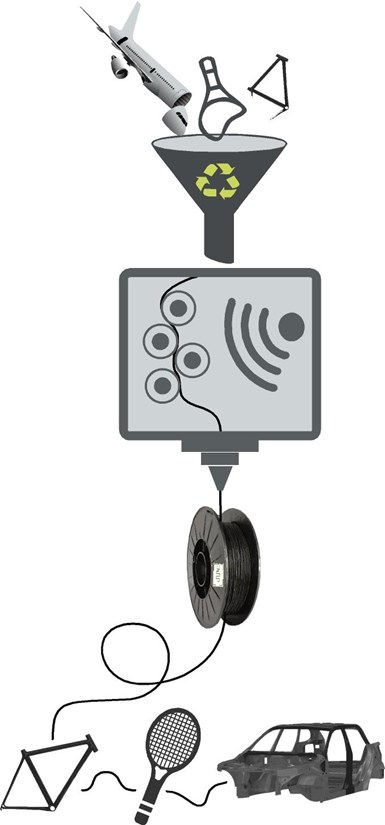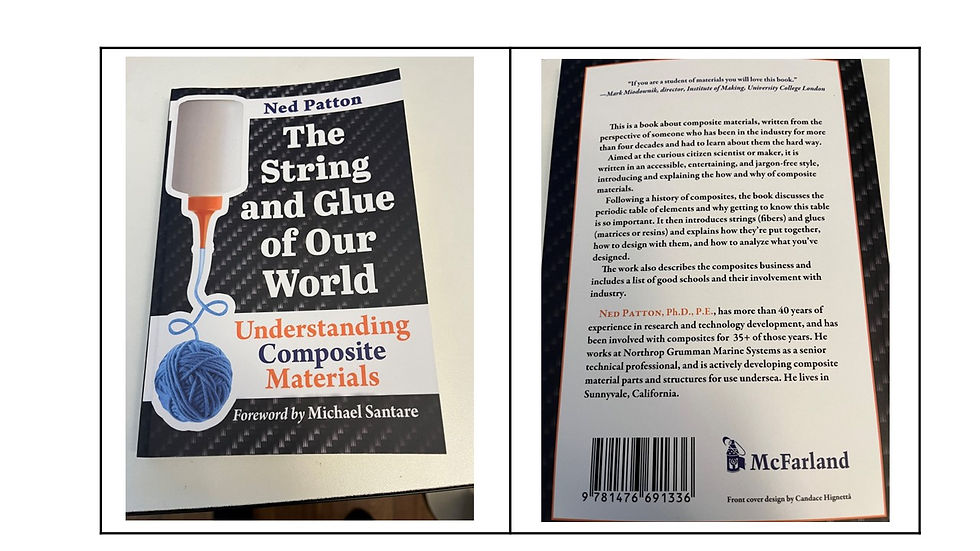A New Entrant in the Recycled Carbon Fiber Scrap Business – Thermoplastic 3D Printing
- Ned Patton

- Aug 5
- 7 min read
There seem to be more new entrants into the use of recycled carbon fiber scrap that pop up every week. And this week is no different. There is an article in the July 30 edition of Composites World news that talks about a new entrant in to this space that is taking recycled carbon fiber scrap, making it semi-continuous by infusing it with a high performance thermoplastic and making it into a continuous filament for use in a 3D printer. They use plastics like PPS (Polyphenylene Sulfide) which is similar to PEEK and PEK in its properties but is a better plastic for 3D printing.

German Aerospace Center DLR (Deutsches Zentrum für Luft- und Raumfahrt) has an Institute of Lightweight Systems that has a development platform that they call EmpowerAX. It is within that Institute that this German Aerospace research center has come up with another way to reuse waste carbon fiber. And they really don’t care where the waste carbon fiber comes from. They are part of the overall European effort to find uses for recycled carbon fiber composites, whether that is in-process scrap or reject parts, or even end of life parts, as long as the carbon fiber is recycled properly and ready to reuse, they can use it. They have apparently been able, using their process, to align the typical short carbon fiber that comes from most recycling processes into a long semi-continuous filament impregnated with a high performance thermoplastic. They apparently do this with a sonic (high frequency sound) infusion process to impregnate these short carbon fibers into a continuous unidirectional filament. My best guess is that they use the high frequency sound most probably focused in one direction to shake the short carbon fibers into alignment while they are infusing them with the molten thermoplastic. Their claim is that they get as much as 50% fiber volume fraction which is actually pretty good. High performance composites made using continuous fiber prepreg only get above 60% when very high performance is required by the part. It is expensive, time consuming, and fairly difficult to remove that much resin from a layup. For high speed manufacturing – the promise of 3D printing – getting over 55-60% fiber fraction is rare.

This project is another example of how the European composites industry has retooled itself as a result of the 1999 EU legislation banning the landfilling of these materials. That legislation, originally intended to target the recreational boating and wind power industries, when it was enacted in 1999 was expanded to include all composite materials. This was because the EU recognized that wind turbine blades, especially in the offshore wind industry, are transitioning from a mostly fiberglass blade to a largely carbon fiber blade. The main spar cap of these enormous blades had already transitioned to carbon fiber just because glass fiber is not strong enough to withstand all of the loads imposed on a wind turbine blade that is as long as a football field (and it doesn’t matter which football you watch the fields are about the same length – 100 vs about 100-130 yards). The designs of the newer offshore turbines require blades that are just too long to be able to use glass fiber, even for just the airfoil portion of the blade.
This is of course because of the economics of the wind power industry. The larger the swept area of any one turbine, the more power you can generate. And you increase power generation faster than the increase in cost to going to longer blades, largely because the major expense is the installation of the foundation and tower. That makes the larger wind turbines generate more power per capital dollar expended. And the operating expenses of a large wind turbine are not much more than a smaller turbine, so the cost of the electricity that the consumer pays goes down the larger the turbines get. This is what is driving the power industry to wind, because the technology to build and install these giant machines has come a long way in the last 20-30 years.
Sorry for the aside here, it’s just that everyone needs to know the motivation for going to larger and longer wind turbine blades. Back to composites.
This German project is just the latest example of a company or research organization in Europe that is focused on the composites sustainability problem, particularly with carbon fiber. This is probably the best place to start because of all of the recycled fibers that are available. After all, recycled carbon fiber has the highest value in that marketplace, especially for high quality fiber.
So, it appears that the process for recycling carbon fiber composites that does not use pyrolysis and keeps the carbon fiber nearly pristine albeit shorter than continuous fiber is a bit more advanced than some that are used for recycling glass fiber composites. This is primarily because of the perceived quality of glass fiber from some earlier processes. This is changing somewhat with the introduction of the process developed by Fiberloop that is being used by Composite Recycling to recycle the fiberglass from used wind turbine blades. The glass fiber that results from the Fiberloop / Composite Recycling process is very high quality in contrast to other methods of recycling wind turbine blade glass fiber, and already has a ready market that these companies are selling their glass into. I have written about this in previous posts, so it is good to see that there is another new entrant in the carbon fiber recycling business as well.
In other news, I came across another interesting development that I must have missed that was described in an article in CW in January of this year (1/21/2025). Apparently some Japanese researchers (Waseda University) had been using high voltage plasma induced shockwave pulse separation of difficult to separate materials for some time. What they thought is that maybe that process might also work with carbon fiber epoxy composites. They had discovered that specifically for lithium ion battery recycling instead of using an indirect method of placing the substances in water and inducing the shock wave pulses in the water, a direct discharge electrical pulse was more efficient at taking apart the materials in these batteries than their water-based shock pulse method. So, they tried it with carbon fiber epoxy effectively to break up the bonds in the epoxy and free the carbon fibers from their epoxy glue.

The resultant fiber that results from this process retains the length of the piece that was recycled and is apparently nearly pristine in its properties. This looks to me like it has real potential to recycle large composite parts without having to chop them up into smaller pieces as is done in most current processes. If this works out, it could be a real game changer in the recycled carbon fiber composites business, especially if they can retrieve long continuous fiber that has close to the same properties as virgin carbon fiber.
All in all it appears that the carbon fiber recycling business is finally going mainstream, especially in European and Asian countries. Here in the U.S. we are unfortunately a bit slow to catch up to all of this, but once the industry in the U.S. finally has the proper motivation to put these sorts of practices in place we will rapidly catch up. There is already evidence of this that I have written about previously, such as the Beneteau consortium that includes Owens Corning Fiberglass, and the Fairmat / Hexcel partnership in Utah for recycling carbon fiber production scrap. With these sorts of solutions popping up in Europe and Japan, it will only be a very brief period before U.S. composite material suppliers and manufacturers will have the motivation to step up. It is clear that without doing so they will rapidly lose market share. None of them want that to happen.
That’s about it for this week. As always, I hope everyone that reads these posts enjoys them as much as I enjoy writing them. I will post this first on my website – www.nedpatton.com – and then on LinkedIn. And if anyone wants to provide comments to this, I welcome them with open arms. Comments, criticisms, etc. are all quite welcome. I really do want to engage in a conversation with all of you about composites because we can learn so much from each other as long as we share our own perspectives. And that is especially true of the companies and research institutions that I mention in these posts. The more we communicate the message the better we will be able to effect the changes in the industry that are needed.
I also wanted to remind everyone that I will be giving a talk and chairing a session at the ICCM conference (International Conference on Composite Materials) at the Baltimore Convention Center this coming Thursday, August 8 if anyone plans on being there. It is being hosted by my alma mater, the University of Delaware to celebrate the 50th anniversary of the founding of the Center for Composite Materials. That’s where I did my doctoral work so I know several of the people who are going to be at the conference. Should be fun. I’ll let everyone know about the conference in the post after this one.
My second book, which may be out in the late fall, is a roadmap to a circular and sustainable business model for the industry which I hope that at least at some level the industry will follow. Only time will tell. As I have said before, my publisher and my daughter have come to an agreement about the cover. So, I’ve included the approved cover at the end of this post. Let me know whether or not you like the cover. Hopefully people will like it enough and will be interested enough in composites sustainability that they will buy it. And of course I hope that they read it and get engaged. We need all the help we can get.
Last but not least, I still need to plug my first book. “The String and Glue of our World” pretty much covers the watershed in composites, starting with a brief history of composites, then introducing the Periodic Table and why Carbon is such an important and interesting element. The book was published and made available August of 2023 and is available both on Amazon and from McFarland Books – my publisher. However, the best place to get one is to go to my website and buy one. I will send you a signed copy for the same price you would get charged on Amazon for an unsigned one, except that I have to charge for shipping. Anyway, here’s the link to get your signed copy: https://www.nedpatton.com/product-page/the-string-and-glue-of-our-world-signed-copy. And as usual, here are pictures of the covers of both books.





Comments